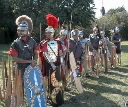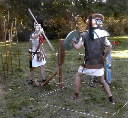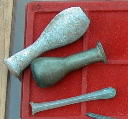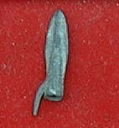|
|

Pastor Loyed Arnold strikes a good pose for displaying various pieces of equipment. The belt, or cingulum supports the pteruges or groin guard. The lorica segmentata is a Corbridge type B. He holds a heavy pilum.
|
|

All six members of Legio X Fretensis present at MacArthur Church and two possible recruits are present in this photograph.
|
|

Antony Lucius and Marcus Scipio explain the entryway to the Roman castrum or camp. Each pilum muralis, or defensive perimeter stake, is joined to its neighbour with rope tied in a half hitch around the stake.
|
|

Dirt is dug out to form a shallow ditch and an earthen rampart just inside of the ditch. The stakes are driven into the top of this earh rampart. An attacking enemy must step into a hole and fight with a defender who has a height advantage.
|
|

We beat our gladii against our shields to strike terror into the hearts of the enemy just before we decimate them with our attack!
|
|
|

Gladius training in the roped off "pit" is about to begin. Who wants to be the first to recieve a painful lesson in the military virtues of quickness and agility?
|
|

Attack high! Attack Low! Ouch! Attack middle! Attack high...!
|
|

These three vials, part of the author's collection, were on display at the MacArthur Church event.
|
|

Shown are two Roman soldiers' thimbles, a heavy bronze needle possibly used on leather or canvas, the end of a bone writing stylus, part of a glass vial, and a broken Celtiberian arrow point, possibly from the Second Punic War period.
|
|

This is one of the barbed arrow points used by Roman auxiliaries all over the ancient Mediterranean world and beyond. The Romans were not known for their skill with bow, but hired expert bowmen from amongst the provinces such as Syria.
|



